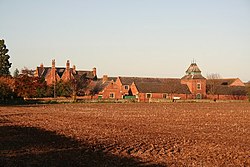Oldcotes
| Oldcotes | |
| Nottinghamshire | |
|---|---|
 Manor Farm, Oldcotes | |
| Location | |
| Grid reference: | SK587887 |
| Location: | 53°23’28"N, 1°7’2"W |
| Data | |
| Post town: | Worksop |
| Postcode: | S81 |
| Dialling code: | 01909 |
| Local Government | |
| Council: | Bassetlaw |
| Parliamentary constituency: |
Bassetlaw |
Oldcotes is a village in the north-west of Nottinghamshire, sitting just half a mile from the border of the West Riding of Yorkshire to the west. It is a little village, centred on the crossroads of the A60 and A634 roads, five miles south-east of Maltby, the latter across the county border.
The history of the village is long and varied. The earliest proof of occupation is the remains of a Roman villa located under the church.[1]
The main focus of the village centres on the Village Hall on Maltby Road, with a history society, bingo, bowls and dancing clubs. There is one public house in the village called the King William.
Hermeston Hall is located just to the south of the village.
Buildings
On the north side of the A634 is The Old Hall, a mid-18th century house with 20th century modifications.[2]
The village war memorial was designed by A H Borrowdale of Worksop, and was unveiled on 18 July 1920 by Colonel H Mellish, of Hodsock Priory. Revd F d'Arblay Burney from Harworth conducted a dedication ceremony on the occasion.[3]
Oldcotes Dyke runs along the southern edge of the village: a mill stream which has supplied the power to drive two water mills, both of which produced flour. Goldthorpe Mill is situated to the west of the A60 Worksop to Tickhill road. It is an early 18th century building, with later additions, and has been converted into a house. It still contains a steel water wheel dating from the late 19th century, and parts of the wooden machinery.[4] Oldcotes Mill is to the east of the village. This dates from the late 18th and early 19th centuries. The wheel drove three sets of stones, and much of the machinery is still in situ. It is inscribed "John Thornton Millwright Engineer & C Worksop".[5]
==Churches
The parish church is dedicated to St Mark, and is situated to the south-west of the crossroads. It was built in 1900 to a design by C Hodgson Fowler. It has a red brick plinth, but the main structure is timber framed, with plaster infill. There is a bell cote at the west end, and the structure is Grade II listed.[6]
At the western end of Main Street is the Roman Catholic Church of St Helen. It was built between 1869 and 1871, and is thought to have been designed by S J Nicholl. It is constructed of ashlar masonry, is set on a plinth, and has a decorative bell turret.[7]
On Blyth Road, is a Wesleyan Chapel dating from 1840. It is built on a plinth, and the walls are rendered.[8] It has since been converted into a house.
Outside links
| ("Wikimedia Commons" has material about Oldcotes) |
References
- ↑ National Heritage List 1006385: Roman Villa at Oldcotes (Scheduled ancient monument entry)
- ↑ National Heritage List 1224492: The Old Hall (Grade II listing)
- ↑ National Heritage List 1421780: Oldcotes War Memorial (Grade II listing)
- ↑ National Heritage List 1045722: Goldthorpe Mill (Grade II listing)
- ↑ National Heritage List 1224490: Oldcotes Mill (Grade II listing)
- ↑ National Heritage List 1224650: Church of St Mark (Grade II listing)
- ↑ National Heritage List 1224607: Church of St Helen (Grade II listing)
- ↑ National Heritage List 1266804: Wesleyan Chapel (Grade II listing)
